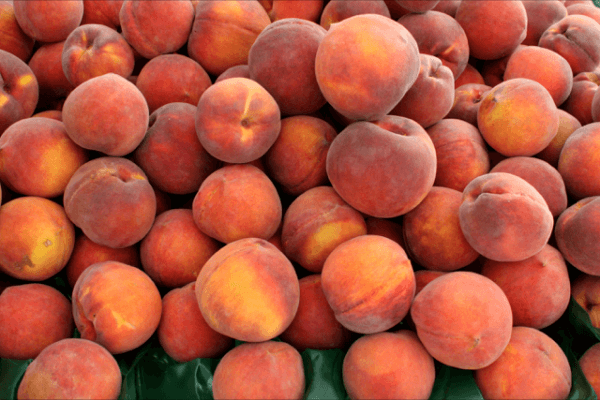Early Candor: Early season variety suitable for Uttar Pradesh.
Red Heaven: Fruit is medium round, yellow hard peel, good quality, matures in June month.
Sunhaven: Early season variety suitable for Uttar Pradesh.
Safeda Early Cream: Suitable for cultivation in Tarai region of Uttar Pradesh.
SRE 6 : Suitable for cultivation in Tarai region of Uttar Pradesh.
July Albert: Fruits are medium sized; peel is light red in color, knot flesh which is yellow in color, soft flesh, fruits are of high quality, matures in second week of July, suitable for packing purposes.
Alexander: Mid-season variety suitable for Uttar Pradesh.
Crawford early: Mid-season variety suitable for Uttar Pradesh.
Parrot Delux: Late season variety.
J.H.Hale: Late season variety.
Other States Variety
Alton: Medium sized fruits, round in shape; flesh is stick with kernel, barium yellow color, peel is slightly bitter, matures in third week of June.
Worlds Earliest: Fruit is small to medium sized; flesh is light brown in color, juicy, stick with kernel, bitter, matures in third week of June.
Early White Giant: Fruit is small to medium sized; sweet flesh, matures in second week of June, flesh gets easily separated from kernel, attractive and aromatic.
Stark Red Gold: Fruit is medium is size, peel is yellow orange which has yellow flesh, medium sticked with flesh, total T.S.S. content is 12.4%, early maturing, matures in last week of May, long plant, spreading and more fruitful.
Snow Queen (Nectarine): Fruit is small to medium sized which is shiny white in color, fruit matures in mid-June, spreading plant, good yield giving variety, suitable for cultivation in the areas at the height of 6000 ft.
Sharbati: - Fruits are large, greenish-yellow colored having rosy patches, very juicy nice flavored, fruits ripen in end-June.
Shan-e- Punjab: It ripens in the 2nd week of May. Fresh fruits are quite big, yellow-colored with radish blush, superb in flavour, as well as free stone. As fruit are rigid in quality, it can tolerate transportation. They are suited to canning; the regular fruit yield is 125kg/tree.
Summer Set: Fruit is medium sized which is yellow-orange in color, sticky flesh, medium spreading variety and is medium yield giving, ripens in End week of June, total T.S.S. content is 12%.
JH HALE.: Fruit is medium sized, round shape, red-purple in color, less sour, ripens in Third week of July.
Silver King (Nectarine): Suitable for cultivation in Kullu hills (1100-1500m), fruit ripens in end week of May to mid-June, greenish-white in color, 3/4th fruit is deep red in color, flesh is creamish-white, sweet in taste, total soluble content is 8-10% and acidic content is 0.6%.
Venus Misoori (Nectarine): Mid-season variety, matures in first week of July, fruit are extra-large in size, green-yellow in color, rough fruit surface, the 3/4th part of fruit is Mahroon-red in color, hard flesh which is crispy and yellow in color, sweet in taste, fruit is beneficial, medium growing tree, high fruiting variety.
Suncrest (Nectarine): Fruit has 102.25gm weight, medium sized long fruits, peel are yellow-orange in color, flesh is orange in color, long kernel having 4.61gm weight, the flesh/kernel is 22.84, T.S.S. brix is 18.4o, acidic content is 0.5%, sucrose content is 14.46% and insoluble sugar content is 8.34%.
Early Grande: Fruit has 82.67gm weight, fruit is medium sized and are long, peel is yellow-green in color, flesh is yellow in color, long kernel having 5.44gm weight, contains 13.36o brix T.S.S. content, acidic content is 0.5%, sucrose content is 14.46% insoluble sugar content is 8.81%.
Suncrest: Mid-season variety ripens in last week of June, large sized fruits having weight of 175gm, round, hard, yellow peel, fruit is sweet and juicy, contains 10.5o brix T.S.S. content.
Glow Heaven: Mid-season variety, fruit are large sized, 190gm weight, round in shape, fruit is sweet and juicy, yellow flesh, contains 11.2o brix T.S.S. content, matures in first week of July.
Prabhat, Pratap, Flordasun, Shan-e- Punjab, Florda red sun, Red (Nectarine), Khurmani, Sharbati, Flordaprince.
Khurmani: - Fruits are large, attractive with red coloration, cling stone with white soft juicy flesh.
Florida Red: - An excellent, mid-season fruits, it matures in the early of June. Fruits are large, almost red at maturity, juicy, with free stone. Its average yield is 100 kg/tree.











